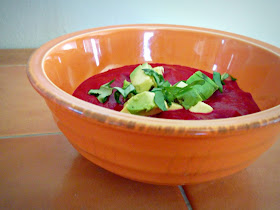
I made a lot of food when I visited my mom last month, and I'm still catching up on those posts. This creamy, tomato-based pea curry was marvelous--I'm still thinking about the smell that filled the kitchen when I was sauteeing all the spices and onions.
Toasted cashews are ground into a paste, giving the impression that there's dairy in the sauce. I used 2 c canned tomatoes instead of fresh, and ended up with lots more sauce. The sauce was delicious, so I wasn't sad about this, but next time I would only use 1 c canned tomatoes. I was also thinking about using green fava beans or edamame rather than peas next time, for more protein. Also, it's not a spicy recipe, so feel free to substitute cayenne in place of aleppo pepper, or to throw in some minced chili if you want some heat--I added a dried red chili when I was sauteeing the ingredients for the masala paste (pictured below:).
Green Pea Curry (Mattar Masala)
(from taste space)
ingredients
1/4 cup raw cashews, chopped
1 tbsp coconut oil, or oil of choice
1 tsp mustard seeds
1 tsp cumin seeds
1/2 tsp fenugreek seeds
4 whole cloves
1 1/2 inch piece cinnamon stick
2 black cardamon pods, slightly crushed
1/2 tsp Aleppo chile flakes
1 medium onion, chopped
1.5 inch piece fresh ginger, chopped
1 clove garlic, chopped
2 medium tomatoes, chopped (I used 2 c canned diced tomatoes; next time I would use only 1 c)
1 cup fresh cilantro, chopped
*
1 tbsp coconut oil, or oil of choice
1 medium onion, finely chopped
2 medium tomatoes, diced
8-10 frozen curry leaves
3 cups green peas (thawed if frozen)
1 tsp turmeric
1 tbsp ground coriander
1/2 tsp Aleppo chile powder
1/2 tsp amchoor powder (optional)
pinch of asafoetida
3/4 tsp garam masala
1 1/2 tsp sea salt, or to taste
fresh cilantro, for garnish
instructions
1. Begin by making the masala paste: In a large skillet over medium-low heat, roast cashews until lightly browned and fragrant, around 5-7 minutes. Remove form heat to cool, then place in a food processor.
2. In the same skillet, heat the oil over medium heat. Once hot, add mustard seeds, cumin seeds and fenugreek seeds and stir for 30-60 seconds, or until the mustard seeds begin to pop. Quickly add the cloves, cinnamon stick, cardamom pods and chile flakes, cover and gently wiggle the skillet occasionally, so the spices do not burn.
3. Add the onion and saute for 5 minutes, until softened and browned. Add the ginger and garlic, stirring for 1 minute more, without allowing to burn. Deglaze with the tomatoes, stirring to incorporate the spices. Cook for 5-10 minutes until thickened, stirring throughout so it does not burn. Stir in the cilantro and allow to wilt, around 1 minute. Remove from heat and add to the food processor. Fish out the cardamom pods and cinnamon sticks because they won’t do anything in the food processor. Next, pulse into you achieve a smooth paste. Return the cinnamon stick and cardamom pods. (This paste can be saved at this point; store in the refrigerator until needed).
4. For the curry, in a large saucepan over medium heat. Once hot, add onion and saute for 5 minutes until softened and lightly brown. Add the tomatoes and curry leaves, simmering until the tomatoes cook down, around 5-10 minutes. Add peas and cook for 4-5 minutes, until the peas are just tender. Stir in the masala paste, turmeric, ground coriander, chile powder, amchoor powder, asafoetida, garam masala and salt. Add 1/2 to 1 cup of water, to achieve your desired level of sauciness. Cover and simmer for another 10 minutes, stirring occasionally so that it does not stick. Add additional water, if required. Remove form heat and let stand for 5 minutes to cool, prior to serving. Fish out the cinnamon stick, cardamom pods and any other bits not pulverized in the masala paste.
5. Serve with your choice of side (pictured with brown rice) and garnish with cilantro, if desired.
Serves 4-6.



















